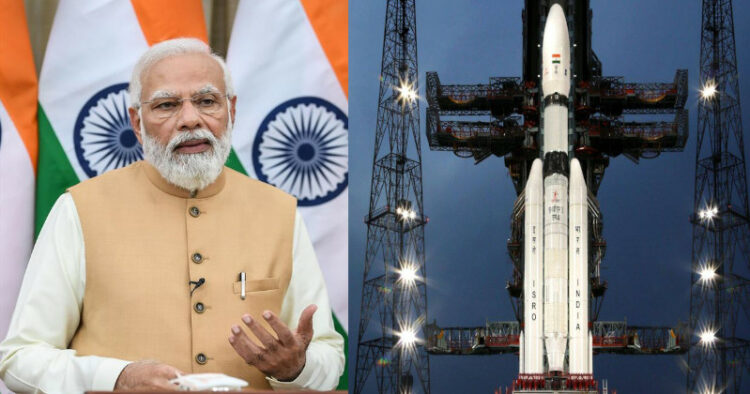July 14, 2023, will always be etched in golden letters in the annals of India’s space sector history, said Prime Minister Narendra Modi, with only hours left for the launch of the much-awaited Chandrayaan-3, India’s third lunar mission.
14th July 2023 will always be etched in golden letters as far as India’s space sector is concerned. Chandrayaan-3, our third lunar mission, will embark on its journey. This remarkable mission will carry the hopes and dreams of our nation. pic.twitter.com/EYTcDphaES
— Narendra Modi (@narendramodi) July 14, 2023
“This remarkable mission will carry the hopes and dreams of our nation,” PM Modi tweeted. The GSLV Mark 3 (LVM 3) heavy-lift launch vehicle, which will release the moon lander and rover into space, will lift off from Satish Dhawan Space Centre in Andhra Pradesh’s Sriharikota at 14:35:17 pm.
The journey from Earth to the moon for the spacecraft is estimated to take about a month and the landing is expected on August 23. Upon landing, it will operate for one lunar day, which is approximately 14 Earth days. One day on the Moon is equal to 14 days on Earth.
The ‘Launch Rehearsal’ simulating the entire launch preparation and process was concluded earlier by the ISRO. Chandrayaan-3 will be ISRO’s follow-up attempt after the Chandrayaan-2 mission faced challenges during its soft landing on the lunar surface in 2019 and was eventually deemed to have failed its core mission objectives.
Best wishes for Chandrayaan-3 mission! I urge you all to know more about this Mission and the strides we have made in space, science and innovation. It will make you all very proud. https://t.co/NKiuxS0QaE
— Narendra Modi (@narendramodi) July 14, 2023
Chandrayaan-3, India’s third lunar exploration mission, will make India the fourth country, after the US, China, and Russia, to land its spacecraft on the surface of the moon and demonstrate the country’s abilities for safe and soft landing on the lunar surface.
Chandrayaan-3 will be inserted into the Lunar Transfer Trajectory after the orbit-raising manoeuvres. Covering over 300,000 km, it will reach the Moon in the coming weeks. Scientific instruments onboard will study the Moon’s surface and enhance our knowledge.
Chandrayaan-3 is equipped with a lander, a rover and a propulsion module. It weighs around 3,900 kilograms.
Moon serves as a repository of the Earth’s past, and a successful lunar mission by India will help enhance life on Earth while also enabling it to explore the rest of the solar system and beyond.
“Thanks to our scientists, India has a very rich history in the space sector. Chandrayaan-1 is considered to be a path breaker among global lunar missions as it confirmed the presence of water molecules on the moon. It featured in over 200 scientific publications around the world,” PM Modi wrote on Twitter.
“Till Chandrayaan-1, the moon was believed to be a bone-dry, geologically inactive and uninhabitable celestial body. Now, it is seen as a dynamic and geologically active body with the presence of water and sub-surface ice,” he further wrote, asserting it might be potentially inhabited in the future.
“Chandrayaan-2 was equally pathbreaking because data from the Orbiter associated with it detected the presence of chromium, manganese and sodium for the first time through remote sensing. This will also provide more insights into the moon’s magmatic evolution.”
The key scientific outcomes from Chandrayaan-2 include the first-ever global map for lunar sodium, enhancing knowledge on crater size distribution, unambiguous detection of lunar surface water ice with IIRS instrument and more. The Mission has been featured in almost 50 publications.
Extending best wishes for the Chandrayaan-3 mission, PM Modi urged citizens to know more about this lunar mission and the strides India has made in space, science and innovation. “It will make you all very proud,” Chandrayaan-3’s development phase commenced in January 2020, with the launch planned sometime in 2021, but the Covid-19 pandemic brought an unforeseen delay to the mission’s progress.
K Sivan, former director of ISRO, told the media that the success of mission Chandrayan-3 will give a morale boost to programmes like Gaganyan, India’s first manned space mission.
“We understood what went wrong with Chandrayan-2 when we could not land on the moon surface, we recreated the failure modes and we ensured that this time we have success. The challenge is the same as Chandrayan-2, same environment for landing. This time we hope that we have done enough based on the lesson of Chandrayan-2 that gives us more confidence. In space there are always unknown unknowns…hope that all issues are addressed and that we emerge with success,” he said.
Director of Indian Space and Research Organisation (ISRO), S Somanath, had said that if everything goes well, the spacecraft will land on the moon on August 23.
The date has been decided based on sunrise on the moon, but if it gets delayed, then landing may take place next month, he said.
















Comments